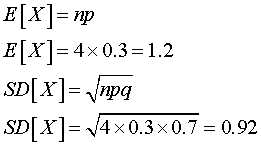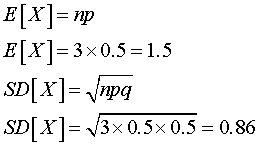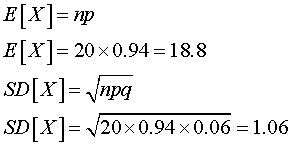The expected value (E[X]) for a random variable X which has a binomial distribution with n trials and a probability of success, p, for each trial. The mean represents the average value that you would see if you repeatedly sampled from the binomial distribution. The standard deviation of X (SD[X]) represents the amount of variability that you would see if you repeatedly sampled from the same binomial distribution. The formulas are:

In the above formula, q represents the probability of failure in a single trial and equals 1-p. Here are some examples:
Suppose that the number of surviving patients out of a series of four liver transplant operations is Bin(n=4,p=0.3). The expected number of survivors would be 1.2 and the standard deviation would be 0.92.
Suppose that the number of girls in a family of three children is Bin(n=3,p=0.5). The expected number of girls would be 1.5 and the standard deviation would be 0.86.
Suppose that the number of patients out of 20 with immunity after a flu vaccine shot is Bin(n=20,p=0.94). The expected number of patients with immunity is 18.8 and the standard deviation is 1.06.



